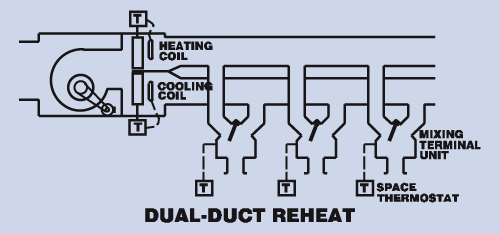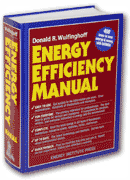Overview of …
4.5 Dual-Duct Reheat Systems
This part of the Energy Efficiency Manual shows you how to save energy in dual-duct reheating air handling systems, also called double duct systems. In dual-duct or double duct systems, the air handling unit has a continuously operating cooling coil that feeds air into a cold air duct, and a continuously operating heating coil that feeds air into a hot air duct. The two ducts run in parallel. At each space, air from the two ducts is mixed in a terminal unit (“mixing box”) that is controlled by the space thermostat.
Most dual-duct systems were designed to provide a constant flow of air to the space. This requires mixing large quantities of heated and chilled air. During low-load conditions, much more energy may be cancelled out by mixing losses than actually enters the space to provide cooling or heating.
Here are the energy conservation measures for optimizing the efficiency of dual-duct reheat systems. By far the largest energy saving opportunity is minimizing the this mixing of hot and cold air. You will learn how to adjust the discharge temperatures or supply air temperatures of the heating and cooling coils to minimize mixing losses. You can do this automatically with supply air temperature reset controls. These methods are inexpensive.
You can save both reheat energy and fan energy by adjusting the fan output as the load changes. Several methods are explained, including variable-speed fan drives. In new construction, none of these methods adds much cost, unless the systems are small.
Achieving the highest level of efficiency in existing systems requires major changes. The most effective is conversion to a variable-air-volume or VAV system. You will learn about temperature control, selection of the heating method, selection of terminal units, diffusers, humidity control, ventilation, and other essential design features.
Click here to return to the Table of Contents


